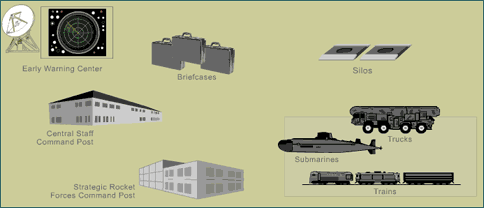|
 |
 |
|
From First Alert to Missile Launch

From the time that satellites first detect a possible nuclear attack, Russian
authorities have only ten minutes to decide whether to launch a counterattack.
This timeline outlines the sequence of events leading to such a launch.
Step 1 of 12
Time elapsed since alert: 00:00:01 - 00:00:59
Time to respond: 00:09:59 - 00:09:01
Within the first minute of a launch, Russian satellites detect missiles in
flight. This information is analyzed by a ground-based early warning system,
which is programmed to look for characteristics specific to
nuclear-warhead-carrying missiles. Operators at the main early-warning center
in Moscow check the initial validity of the indicators and then relay the
information to the General Staff Command Post, which is located at Chekhov,
about 60 miles south of Moscow.
Step 2 of 12
Time elapsed since alert: 00:01:00 - 00:01:59
Time to respond: 00:09:00 - 00:08:01
Personnel at the General Staff Command Post check on the reliability of the
report. If they decide it is valid, they send out an alert to the three
"nuclear briefcases." One briefcase is with the president, one is with the
defense minister, and one is with the chief of the General Staff Command Post
(who may or may not be at the command post at the time). They also send out an
alert to the Strategic Rocket Forces command post. The Strategic Rocket Forces
is an elite crew that controls and maintains the country's missiles.
The briefcase looks similar to a laptop computer when opened. It is designed to
receive and display the early-warning information, which is relayed through the
General Staff Command Post. The briefcase also allows the president to transmit
an order to launch missiles. To make such an order, the president must transmit
the permission code, which is contained within the briefcase. The permission
code prompts the leaders at the Command Post to send out the launch
authorization codes, the unblocking codes, and a war plan to missile sites and
land- and sea-based mobile launchers. In addition to the briefcase, other
equipment is always near the president. This equipment allows him to
communicate with the other leaders. The system outlined here is similar to the
one used in the U.S.
Step 3 of 12
Time elapsed since alert: 00:02:00 - 00:02:59
Time to respond: 00:08:00 - 00:07:01
The General Staff Command Post turns on a special communications circuit, which
connects the post to all missile sites and mobile launchers. The mobile
launchers include trucks, trains, and submarines. The crews make preparations
to launch.
Step 4 of 12
Time elapsed since alert: 00:03:00 - 00:03:59
Time to respond: 00:07:00 - 00:06:01
The three carrying briefcases confer with one another by phone. They also
communicate with the early-warning centers to confirm that missiles are headed
toward Russia.
Step 5 of 12
Time elapsed since alert: 00:04:00 - 00:04:59
Time to respond: 00:06:00 - 00:05:01
The incoming missiles are now within range of ground-based radar centers. The
centers validate the satellite reports.
Step 6 of 12
Time elapsed since alert: 00:05:00 - 00:05:59
Time to respond: 00:05:00 - 00:04:01
To successfully launch a counterattack, the president must make a decision now.
If he decides to strike, he'll transmit the permission codes that are contained
within the briefcase to the General Staff Command Post, to airforce and navy
command posts, and to the Strategic Rocket Forces command post. Over the next
few minutes, he can rescind his order to launch.
Step 7 of 12
Time elapsed since alert: 00:06:00 - 00:06:59
Time to respond: 00:04:00 - 00:03:01
The General Staff Command Post transmits the authorization codes, the war plan
(which includes targets and the time to launch missiles), and the unblocking
codes. Without the unblocking codes, it is theoretically impossible to launch
any missiles. (Deterioration of the control systems, however, has made
unauthorized launch a remote but real possibility.)
Step 8 of 12
Time elapsed since alert: 00:07:00 - 00:07:59
Time to respond: 00:03:00 - 00:02:01
The strategic launchers are prepared for launch. Safety procedures require that
the commanding officers at each missile site confirm that the orders are
genuine. They do this by comparing the final authorization codes they received
against codes that are kept in a safe.
The officers begin to implement launch procedures.
Step 9 of 12
Time elapsed since alert: 00:08:00 - 00:08:59
Time to respond: 00:02:00 - 00:01:01
The commanding officer at each missile site activates the site's missile system
with a safety key. The unblocking codes are then entered.
Step 10 of 12
Time elapsed since alert: 00:09:00 - 00:09:59
Time to respond: 00:01:00 - 00:00:01
The commanding officers are completing final launch procedures.
Step 11 of 12
Time elapsed since alert: 00:09:00 - 00:09:59
Time to respond: 00:01:00 - 00:00:01
Unless they receive an order that rescinds the previous order, the commanding
officers launch the missiles.
Step 12 of 12
Time elapsed since alert: 00:10:00 - 00:15:59
Time to respond: 00:00:00 - 00:00:00
At this time in this simulation, the Russian missiles are five minutes into
their 25-minute flight to the United States. If the U.S. attack is real, its
missiles begin to hit their targets.
These are the steps that Russian authorities and missile forces would go
through whether the alert was triggered by a false alarm or a genuine
attack.
The Director's Story |
False Alarms on the Nuclear Front
Global Guide to Nuclear Missiles |
From First Alert to Missile Launch
Resources |
Transcript |
Site Map |
Russia's Nuclear Warriors Home
Search |
Site Map |
Previously Featured |
Schedule |
Feedback |
Teachers |
Shop
Join Us/E-Mail |
About NOVA |
Editor's Picks |
Watch NOVAs online |
To print
PBS Online |
NOVA Online |
WGBH
© | Updated October 2001
|
|
|
|